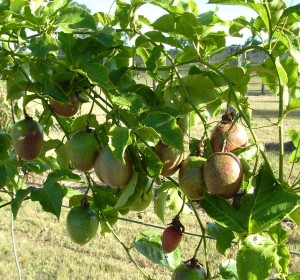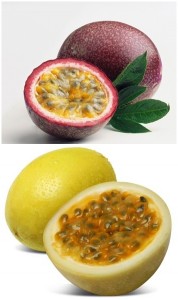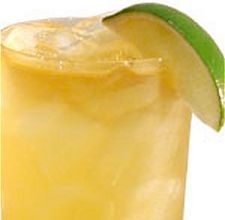Feel the Passion for Passion Fruit Juice
The Passion fruit
Passion fruit is a fruit that grows on climbing vines that cling by tendrils to any strong
support that hey can find. It is scientifically known as Passiflora edullis and is indigenous to Brazil and Northern Argentina. Passion fruit is round to oval in shape, either yellow or dark purple when ripe, with a juicy, tender to firm inner portion filled with numerous seeds.
Passion fruit exists in two identifiable varieties, the Golden Passion fruit and the Purple Passion fruit. Golden Passion fruit has a bright yellow exterior and can grow as big as a grapefruit. Its skin is smooth, glossy and light. On the other hand, the dark purple passion fruit has obviously a dark purple exterior, and smaller than a lemon. It is less acidic but has a richer aroma and flavor.
Where Passion Fruits are Cultivated
Passion fruit can be found originally in Paraguay, Brazil and Northern Argentina. Today, it is grown commercially in warmer, frost–free countries like India, Sri Lanka, Caribbean, Colombia, Bolivia, Ecuador and some other parts of Central America. It is also widely grown in New Zealand, East Africa, Israel and Portugal.
In UK and US, it is called passion fruit or passionfruit in Australia and New Zealand. On the other hand, It is known as “gulupa” or “maracuya” in Colombia.

Passion Fruit’s Juice and Culinary Uses
Passion fruit has rich flavor and aroma. Because of this, it is often used for culinary purposes. Most commonly, passion fruit is eaten raw or turned into a juice that is a refreshing drink. The interior part of the passion fruit is where its aroma and taste originate. It contains an aromatic mass of membranous sacs filled with pulpy liquid and tiny but numerous seeds. It’s naturally juicy so juicing it is quite easy. The riper the fruit is, the sweeter its taste. Therefore, it is best to use ripe passion fruits when juicing to extract perfectly sweet flavors.
Nutrition Facts of Passion Fruit
(per 236 g)
Vitamin A: 1,652 IU
Vitamin C: 70.8 mg
Fiber: 24.5 g
Carbohydrates: 55 g
Protein: 5.2 g
Fat: 1.6 g
Don’t Miss Passion Fruit Health Benefits
Rich in Antioxidant Vitamins plus Anti-cancer Properties
Passion fruit, according to its nutritional profile, is very rich in Vitamins A and C. These vitamins not only boost the function of our immune system to fight diseases, but also act as powerful antioxidants. Vitamins A and C both remove free radicals in our body, thus inhibiting skin and tissue damage, as well as effects of aging. Other antioxidants found in passion fruit have been discovered to inhibit the growth of cancer cells.
It Stimulates Digestive Function
The juice of passion fruit and the fruit itself are said to stimulate functioning of digestive tract, thus keeping it healthy and reducing the exposure time to waste and toxins. These effects are also helpful in treating other digestive ailments.
It is Fiber-Rich
The seeds of passion fruit contain a significant amount of fiber that our body needs to cleanse the colon, remove waste and improve digestion.
Aids in the Treatment of Asthma
Passion fruit is believed to contain compounds that block histamine, thus, reducing inflammation and other symptoms of allergy. Its anti-inflammatory effects are said to be effective in alleviating symptoms of asthma.
Passion Fruit Juice Recipe
Ingredients:
- 10 passion fruits
- 3 ½ tablespoons sugar
- Water (for dilution)
- 3 lemons
- Cut off the tops of each passion fruit, then scoop the pulp into the bowl.
- Using a sieve or strainer, rub the pulp to extract the juices.
- Put the seeds and the pulps left on the sieve in a separate bowl. Add ½ cup of boiling water, cover and let it stand for a few minutes until cool enough.
- If you have a blender, you can skip steps 2 and 3 and immediately blend the pulps together with sugar, lemon juice and some water for dilution. Blend for a few minutes and strain the juice using a strainer to remove unwanted pulps.
- If you’re following steps 2 and 3, strain the juice once again through clean cheesecloth, squeezing thoroughly to extract all the juices and remove pulps. Add desired amount of water to dilute, sugar and lemon juice.
- Serve with ice cubes!
Other Interesting Passion Fruit Facts
The name “passion fruit” was given to this fruit by Spanish Missionaries a long time ago. They thought some parts of the flowers look like nails and hammers, and the flower as a whole resembles a crown of thorns on Christ’s head during the crucifixion. That’s why they call it passion fruit.
We should also be aware that some parts of this fruit are poisonous. Poisonous parts include the roots, stem and leaves which shouldn’t be included when using passion fruit for juicing or cooking.
Fruit is also used as cattle or pig food. The rind of the fruit is roughly chopped, dried and combined with molasses.
Other Passion Fruit Articles
Best Passion Fruits for Juicing and How to Choose Them
Passion fruit can be used in many different ways when …Passion Fruit Juice Side Effects
Passion fruit juice has no known severe side effects. However, …Health Benefits of Passion Fruit Juice
Passion fruit juice is a bright, refreshing way to get …Passion Fruit Nutrition Facts
Passion Fruit Nutrition Facts Betaine 0 mg Calcium 0,4 mg …

